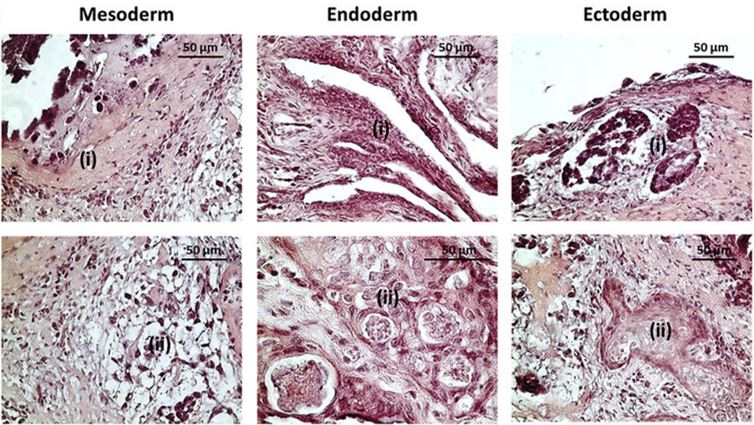- You are here: Home
- Services
- Stem Cell Research
- iPSC Characterization
- Teratoma Formation Assay
Services
-
Cell Services
- Cell Line Authentication
- Cell Surface Marker Validation Service
-
Cell Line Testing and Assays
- Toxicology Assay
- Drug-Resistant Cell Models
- Cell Viability Assays
- Cell Proliferation Assays
- Cell Migration Assays
- Soft Agar Colony Formation Assay Service
- SRB Assay
- Cell Apoptosis Assays
- Cell Cycle Assays
- Cell Angiogenesis Assays
- DNA/RNA Extraction
- Custom Cell & Tissue Lysate Service
- Cellular Phosphorylation Assays
- Stability Testing
- Sterility Testing
- Endotoxin Detection and Removal
- Phagocytosis Assays
- Cell-Based Screening and Profiling Services
- 3D-Based Services
- Custom Cell Services
- Cell-based LNP Evaluation
-
Stem Cell Research
- iPSC Generation
- iPSC Characterization
-
iPSC Differentiation
- Neural Stem Cells Differentiation Service from iPSC
- Astrocyte Differentiation Service from iPSC
- Retinal Pigment Epithelium (RPE) Differentiation Service from iPSC
- Cardiomyocyte Differentiation Service from iPSC
- T Cell, NK Cell Differentiation Service from iPSC
- Hepatocyte Differentiation Service from iPSC
- Beta Cell Differentiation Service from iPSC
- Brain Organoid Differentiation Service from iPSC
- Cardiac Organoid Differentiation Service from iPSC
- Kidney Organoid Differentiation Service from iPSC
- GABAnergic Neuron Differentiation Service from iPSC
- Undifferentiated iPSC Detection
- iPSC Gene Editing
- iPSC Expanding Service
- MSC Services
- Stem Cell Assay Development and Screening
- Cell Immortalization
-
ISH/FISH Services
- In Situ Hybridization (ISH) & RNAscope Service
- Fluorescent In Situ Hybridization
- FISH Probe Design, Synthesis and Testing Service
-
FISH Applications
- Multicolor FISH (M-FISH) Analysis
- Chromosome Analysis of ES and iPS Cells
- RNA FISH in Plant Service
- Mouse Model and PDX Analysis (FISH)
- Cell Transplantation Analysis (FISH)
- In Situ Detection of CAR-T Cells & Oncolytic Viruses
- CAR-T/CAR-NK Target Assessment Service (ISH)
- ImmunoFISH Analysis (FISH+IHC)
- Splice Variant Analysis (FISH)
- Telomere Length Analysis (Q-FISH)
- Telomere Length Analysis (qPCR assay)
- FISH Analysis of Microorganisms
- Neoplasms FISH Analysis
- CARD-FISH for Environmental Microorganisms (FISH)
- FISH Quality Control Services
- QuantiGene Plex Assay
- Circulating Tumor Cell (CTC) FISH
- mtRNA Analysis (FISH)
- In Situ Detection of Chemokines/Cytokines
- In Situ Detection of Virus
- Transgene Mapping (FISH)
- Transgene Mapping (Locus Amplification & Sequencing)
- Stable Cell Line Genetic Stability Testing
- Genetic Stability Testing (Locus Amplification & Sequencing + ddPCR)
- Clonality Analysis Service (FISH)
- Karyotyping (G-banded) Service
- Animal Chromosome Analysis (G-banded) Service
- I-FISH Service
- AAV Biodistribution Analysis (RNA ISH)
- Molecular Karyotyping (aCGH)
- Droplet Digital PCR (ddPCR) Service
- Digital ISH Image Quantification and Statistical Analysis
- SCE (Sister Chromatid Exchange) Analysis
- Biosample Services
- Histology Services
- Exosome Research Services
- In Vitro DMPK Services
-
In Vivo DMPK Services
- Pharmacokinetic and Toxicokinetic
- PK/PD Biomarker Analysis
- Bioavailability and Bioequivalence
- Bioanalytical Package
- Metabolite Profiling and Identification
- In Vivo Toxicity Study
- Mass Balance, Excretion and Expired Air Collection
- Administration Routes and Biofluid Sampling
- Quantitative Tissue Distribution
- Target Tissue Exposure
- In Vivo Blood-Brain-Barrier Assay
- Drug Toxicity Services
Teratoma Formation Assay
Derived from various adult somatic cell types via the introduction of four specific transcription factors, induced pluripotent stem cells (iPSCs) have the ability to differentiate into derivatives of all three germ layers and show great potential in fields ranging from regenerative medicine to disease modeling. A teratoma is a nonmalignant tumor comprised of a disorganized mixture of cells and small foci of tissue comprised of cells from all three of the embryonic germ-layers.
With any iPSC lines, it is necessary to confirm pluripotency and characterize the cell lines before the following downstream regulation experiments. Teratoma formation is an essential criterion to determine the pluripotency and assess the tumorigenic potential of human iPSCs. Currently, Creative Bioarray has established a standard protocol for teratoma assay based on subcutaneous co-transplantation of human iPSCs with mitotically inactivated feeder cells and Matrigel into immunodeficient mice.
 Figure 1. A simple grading scale for monitoring teratoma development.
Figure 1. A simple grading scale for monitoring teratoma development.
Workflow of Teratoma Formation Assay service:
- Thawing and preparing of iPSCs for injection.
- Injection of iPSCs into the immunodeficient mice.
- Excision and fixation of teratoma for paraffin embedding
- Analyzing histology sections for germ layers to confirm pluripotency
Samples required: 2 vials, 10^6 cells/vial
Deliverables:
- HE staining images of three germ layer, including Mesoderm, Endoderm, Ectoderm.
- Paraffin embedded tissue sections
- Project report
 Figure 2. A representative microscopic image of H&E-stained teratoma sections showing iPSC-derived tissues of all three germ layers.
Figure 2. A representative microscopic image of H&E-stained teratoma sections showing iPSC-derived tissues of all three germ layers.
Creative Bioarray is an experienced and outstanding provider of Teratoma Formation Assay service. We are dedicated to providing quality data and comprehensive service for your scientific research, and we are pleased to use our extensive experience and advanced platform to offer the best service to satisfy each demand from our customers.
If you have any special need in Teratoma Formation Assay service, do not hesitate to contact us for this special service. Please let us know what you need and we will accommodate you. We look forward to working with you in the future.
Explore Other Options
For research use only. Not for any other purpose.

